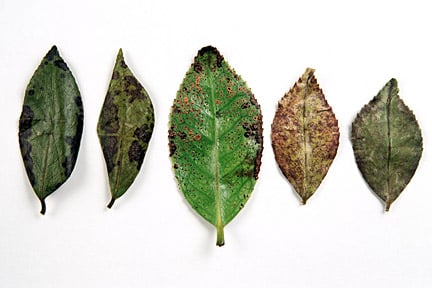
Quick facts
Common name - Oedema
Scientific name - Oedema
Plants affected - Various; including cacti, camellias, eucalyptus, fuchsia, orchids, pelargonium, succulents and vines
Main causes - Excessively high moisture levels in soil or air
Timing - All year
What is oedema?
Oedema is a disorder of plants caused by the roots taking up more water than the leaves can transpire. This excess water ruptures the cells, particularly on the undersides, and leads to water-soaked patches that turn corky and unsightly.
Symptoms
A plant suffering from oedema may show a number of symptoms:
- Water-soaked spots appear first on the leaves. These then become raised, warty or pimple-like swellings or growths
- The growths can rupture and have a white, powdery appearance or may become rust-coloured and appear as scaly patches. These can sometimes be confused with other disorders or diseases, such as fuchsia rust
- Corky spots or ridges may develop, particularly on woody plants such as camellias
Prevention
Once oedema has occurred, affected leaves should not be picked off as this will make the condition worse. Instead, improve conditions (see below) both in the air and soil to encourage healthy new growth to develop.
For conservatory or glasshouse plants, maintain adequate especially in hot, sunny weather to allow the air to circulate. Make sure you water the plants carefully and do not allow the plants to completely dry out or become waterlogged. Both will impair the roots ability to function well.
If container plants show signs of oedema, check the is free-draining. If plants are too wet, repotting with fresh compost is advisable.
Plants frequently affected include: cacti, echeveria and the semi-succulent Peperomia spp., some greenhouse fruit, orchids and pelargonium (greenhouse geraniums).
If outdoor plants such as camellias or eucalyptus show signs of oedema, check the soil condition for waterlogging and flooding, particularly following heavy rain. Improve soil texture by incorporating organic matter such as leaf mould or well-rotted manure and do not plant on clay soil when very wet. For plants growing in permanent containers, decrease watering and try to improve drainage by using pot feet or repotting, if necessary.
Causes
The main causes of oedema include:
- Excessively moist conditions in the soil or growing medium, in the atmosphere, or in combination, which give the plant cells an unusually high water content
- When foliage is reduced by the removal of leaves or shoots
- Occasionally oedema can occur as a reaction to some chemical sprays such as insecticide or fungicide




